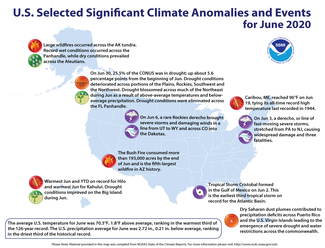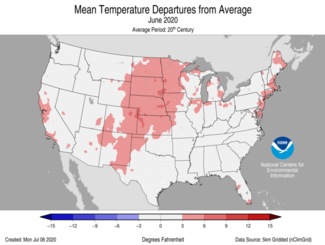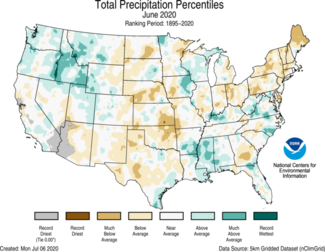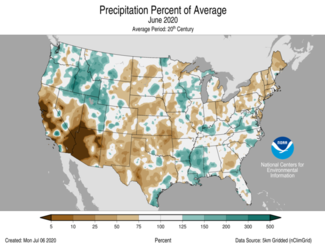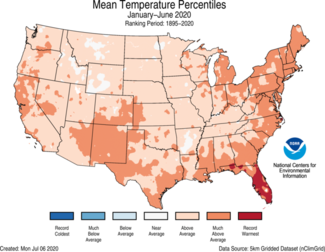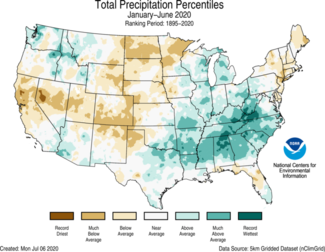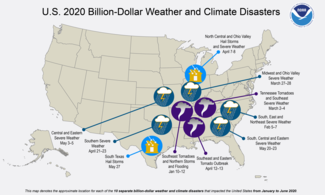Contiguous U.S. experienced a warm, dry June, and Alaska ranked seventh wettest for the month

The June contiguous U.S. temperature was 70.3°F, 1.8°F above the 20th-century average, ranking in the warmest third of the 126-year record. The year-to-date average temperature for the contiguous U.S. was 50.0°F, 2.4°F above the 20th-century average, and ranked eighth warmest in the January-June record.
The June precipitation total for the contiguous U.S. was 2.72 inches, 0.21 inch below average, and ranked in the driest third of the 126-year period of record. Despite the dry conditions during June, the precipitation total for January-June was 16.32 inches, 1.01 inches above average, and ranked in the wettest third of the 126-year record.
There were 10 billion-dollar weather and climate disasters identified during January-June, which makes 2020 the sixth consecutive calendar year where 10 or more separate events were identified — a new record. All 10 disasters were due to severe storms with impacts from tornadoes, hail and high wind damage across more than 30 states.
This monthly summary from NOAA National Centers for Environmental Information is part of the suite of climate services NOAA provides to government, business, academia and the public to support informed decision-making.
June Temperature
-
The primary circulation pattern during June was a ridge over the Great Plains with troughs along the East and West coasts. This brought above-average heat to the central U.S. and kept parts of the West and Southeast cooler than average.
-
Above-average June temperatures were observed across portions of the West and Gulf coasts as well as from the Southwest to the northern Plains and from the Great Lakes into New England. Rhode Island, Delaware, Minnesota and Kansas ranked eighth warmest for the month.
-
Below-average June temperatures were scattered across portions of the Deep South, Southeast and northern Rockies. However, only South Carolina ranked in the coolest third of its historical distribution for the month.
-
The Alaska average June temperature was 50.5°F, 1.3°F above the long-term mean and ranked in the warmest third of the historical record for the state. Overall, western Alaska was warmer than average while the southeastern part of the state was near or below average for the month.
-
Sea ice melt in the Chukchi Sea was slower than average for this time of year. June sea ice extent was 92% of average, which is the highest amount for June observed since 2017 and much higher than the record low extent observed during June 2019.
-
June Precipitation
-
Above-average precipitation was observed across portions of the Pacific Northwest, northern and central Rockies, Great Lakes, Deep South and the Mid-Atlantic regions. Idaho ranked 13th wettest while an additional 10 states ranked in the wettest third of their historical distribution for June.
-
Below-average precipitation occurred across portions of the Southwest, Great Plains, Ohio Valley, Southeast and much of the Northeast. Maine ranked 13th driest while 16 additional states ranked in the driest third of their record for June.
-
Alaska received 3.24 inches of precipitation during June, which is 0.90 inch above average and ranked seventh wettest on record. Both Juneau and Ketchikan in the Panhandle had their wettest June on record. Across the Interior, Northway, Delta Junction and Fairbanks had a top-five wettest June, while Denali National Park ranked sixth wettest.
-
According to the June 30 U.S. Drought Monitor report, approximately 25.5 percent of the contiguous U.S. was in drought, up from nearly 20 percent at the beginning of June. Drought conditions expanded or intensified across portions of the Plains, Rockies, Southwest, Northwest and Puerto Rico. Drought blossomed across much of the Northeast during June as a result of above-average temperatures and below-average precipitation. Drought conditions improved across parts of Hawaii and were eliminated across the Florida Panhandle.
Year-to-date (January-June) Temperature
-
Above-average to record-warm January-June temperatures were observed across the vast majority of the Lower 48 states. Florida ranked warmest on record for this six-month period while New Jersey ranked third warmest and Rhode Island and Massachusetts ranked fourth warmest.
-
The Alaska statewide average temperature for the year-to-date period was 21.4°F, 0.1°F below average, and ranked in the middle third of the record. Above-average temperatures were located across the Aleutians, part of the West Coast region and portions of the eastern North Slope. Below-average temperatures were concentrated across much of the Southeast Interior, Cook Inlet and southern Northeast Interior regions.
Year-to-date (January-June) Precipitation
-
Above-average precipitation occurred across portions of the Northwest and Southwest and from Texas to the Great Lakes and into the Southeast. Tennessee ranked wettest on record, North Carolina ranked fourth wettest and West Virginia and Alabama ranked fifth wettest for this year-to-date period.
-
Below-average precipitation was observed from the West Coast into parts of the central and southern Rockies and from the southern High Plains to the Northern Tier. Below-average conditions were also present across the Northeast and parts of Florida. North Dakota had the sixth driest and Colorado eighth driest January-June on record.
Billion-dollar Weather and Climate Disasters
-
Through the end of June, 10 weather and climate disaster events have been identified, with losses exceeding $1 billion each across the U.S. during 2020. All 10 events were due to severe storms, which occurred across more than 30 states from the Great Lakes to the Gulf Coast.
-
In addition to significant economic impacts, these events resulted in 80 fatalities.
-
This is a record sixth consecutive year with at least 10 separate billion-dollar disasters and is at near-record pace for billion-dollar disasters during the first half of the year — 2020 is tied with 2011 and 2016, but trailing 2017 by one event.
-
Since these records began in 1980, the U.S. has sustained 273 separate weather and climate disasters where overall damages/costs reached or exceeded $1 billion (based on the CPI adjustment to 2020) per event. The total cost of these 273 events exceeds $1.75 trillion.

